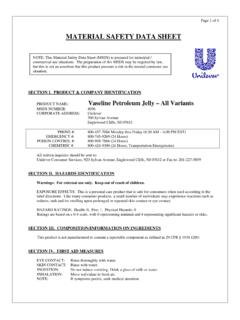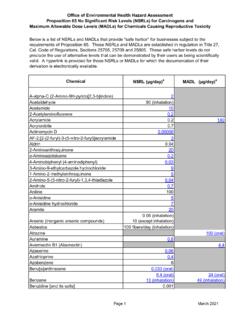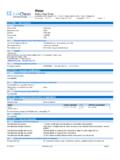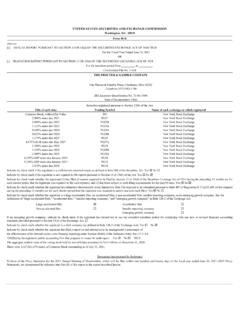Transcription of Frequently Asked Questions About Proposition 65
1 Proposition 65: Frequently Asked Questions (March 2014) Proposition 65: Frequently Asked Questions Q: I recently bought a product that came with a Proposition 65 warning. How do I find out more About the warning and the chemicals in the product? A: To request more information regarding the chemical exposures that are the basis of the warning, contact the manufacturer of the product. Businesses are not required to provide OEHHA with any information regarding their decision to provide a Proposition 65 warning. This decision is made by each business based on its knowledge of the types of chemical exposures it is responsible for causing to individuals.
2 Because we do not know why a business has chosen to provide a warning, we generally cannot respond to specific Questions regarding product safety, the reason a warning is being given, or the listed chemical for which the warning is being given. We also cannot answer Questions regarding how long and at what level the chemical exposures have been occurring. The responses to these Questions should be requested from the business providing the warning. The Proposition 65 list of chemicals is available at Q: Is a product safe if it carries a Proposition 65 warning? A: The purpose of Proposition 65 is to notify consumers that they are being exposed to chemicals that are known to cause cancer and/or reproductive toxicity.
3 Consumers can decide on their own if they want to purchase or use the product. A Proposition 65 warning does not necessarily mean a product is in violation of any product-safety standards or requirements. For additional information About the warning, contact the product manufacturer. Other state public health officials and federal government agencies are responsible for regulating product safety. For example, the California Department of Public Health issues recalls of food products found to be unsafe. The federal Food and Drug Administration regulates food, drug, cosmetic and medical device products.
4 Other types of consumer products, including toys, jewelry, personal care products, and other non-food items, are regulated by the federal Consumer Product Safety Commission, which also may issue recalls for products found to be unsafe. Finally, the California Air Resources Board may ban products that harm the air we breathe. Page 1 Updated March 6, 2014 Proposition 65: Frequently Asked Questions (March 2014) Q: My landlord just posted Proposition 65 warning signs at my apartment complex. Why is my landlord posting these warnings? A: Tenants should ask their landlords for specific information regarding Proposition 65 warnings at their apartment building.
5 Property owners and managers are not required to notify OEHHA when they provide tenants with a Proposition 65 warning or explain the reasons for the warning. You can find general information on what tenants should know About Proposition 65 by reading our fact sheet for tenants. Q. Is toxic mold subject to the requirements of Proposition 65? A. No. Toxic mold is not included on the Proposition 65 list of carcinogens or reproductive toxicants because that list only identifies chemicals. The California Department of Public Health is the lead state agency responsible for regulation of mold.
6 The department has published a fact sheet on toxic mold in homes. Other information resources on toxic mold can be found at: ( type in search word "mold") ( type in search word "mold") Are any businesses exempt from Proposition 65? A. Yes. Small businesses with fewer than 10 employees, governmental agencies, and public water systems are exempt from the warning requirement and discharge prohibition of Proposition 65. Q: Are government agencies required to disclose illegal discharges of hazardous materials under Proposition 65? A: Certain employees of the government are required to disclose illegal and threatened illegal discharges of hazardous waste to the county board of supervisors and the local health officer.
7 Additional information About this disclosure requirement is available at This r equirement is separate from the public warning requirements of Proposition 65. Q: As a business, how do I know if I need to provide a Proposition 65 warning? A: Using your knowledge of your business operations and the chemicals you use, review the Proposition 65 list to determine whether your operations or products are likely to expose individuals to any listed chemicals. Depending on the level of exposure, you may be required to provide a warning for those exposures. Page 2 Proposition 65: Frequently Asked Questions (March 2014) OEHHA adopts safe harbor levels (levels of exposure that trigger the warning requirement) for many listed chemicals.
8 Businesses that cause exposures greater than the safe harbor level must provide Proposition 65 warnings. OEHHA does not have safe harbor levels for all listed chemicals. If there is no safe harbor level, businesses that expose individuals to that chemical would be required to provide a Proposition 65 warning, unless the business can show that the anticipated exposure level will not pose a significant risk of cancer or reproductive harm. OEHHA has adopted regulations that provide guidance for calculating a level in the absence of a safe harbor level. Regulations are available at Article 7 and Article 8 of Title 27, California Code of Regulations.
9 Determining anticipated levels of exposure to listed chemicals can be very complex. Although a business has the burden of proving a warning is not required, you are discouraged from providing a warning that is not necessary and instead should consider consulting a qualified professional if you believe an exposure to a listed chemical may not require a Proposition 65 warning. Q. What is the acceptable concentration in my product for chemicals listed under Proposition 65? A. Proposition 65 applies only to exposures to listed chemicals. It does not ban or restrict the use of any given chemical.
10 The concentration of a chemical in a product is only one part of the process to determine whether consumers must be warned About an exposure to a listed chemical. As explained above, OEHHA provides businesses with compliance assistance by establishing safe harbor levels for exposures to listed chemicals. Exposures below those levels do not require a warning. In general, a business should combine known information About how consumers use their product and how they might be exposed to a listed chemical. For example, a toy might contain small amounts of lead or other listed chemicals in its paint.














